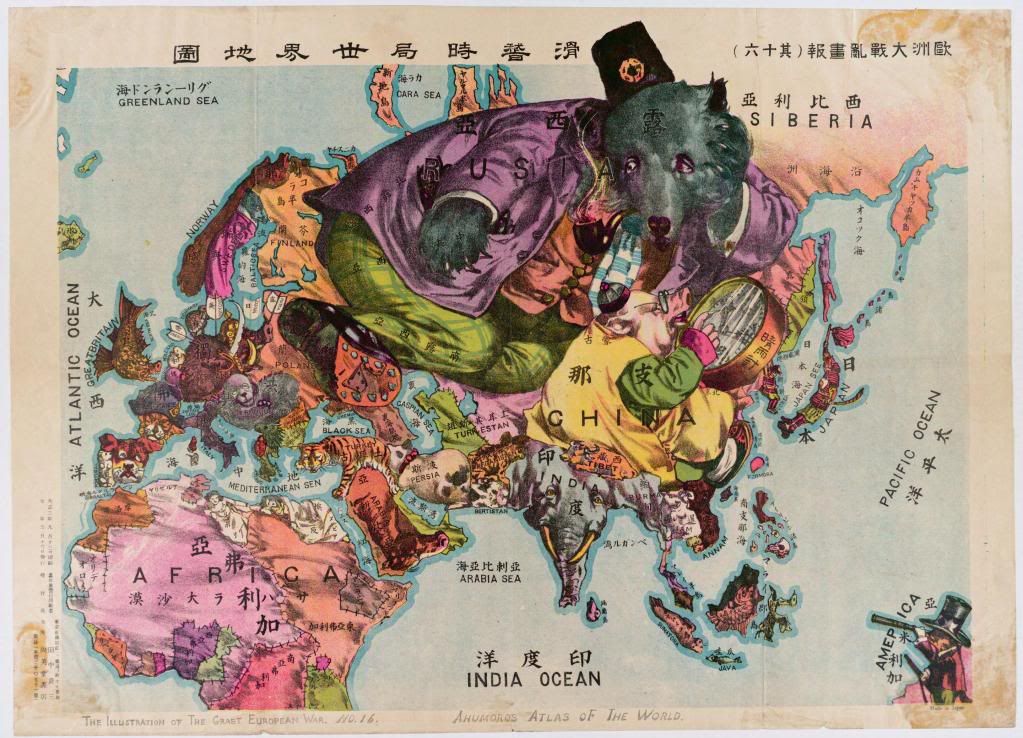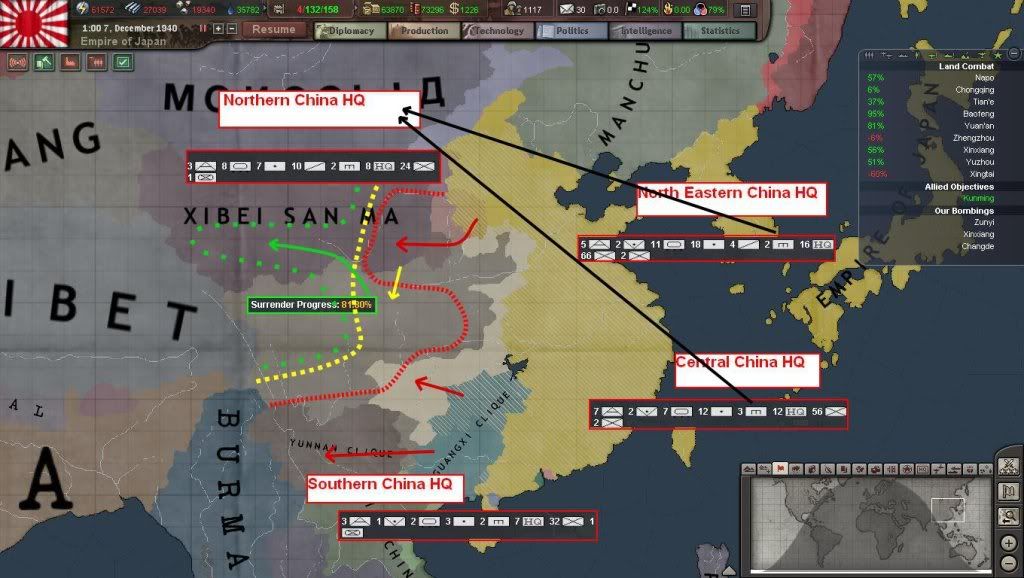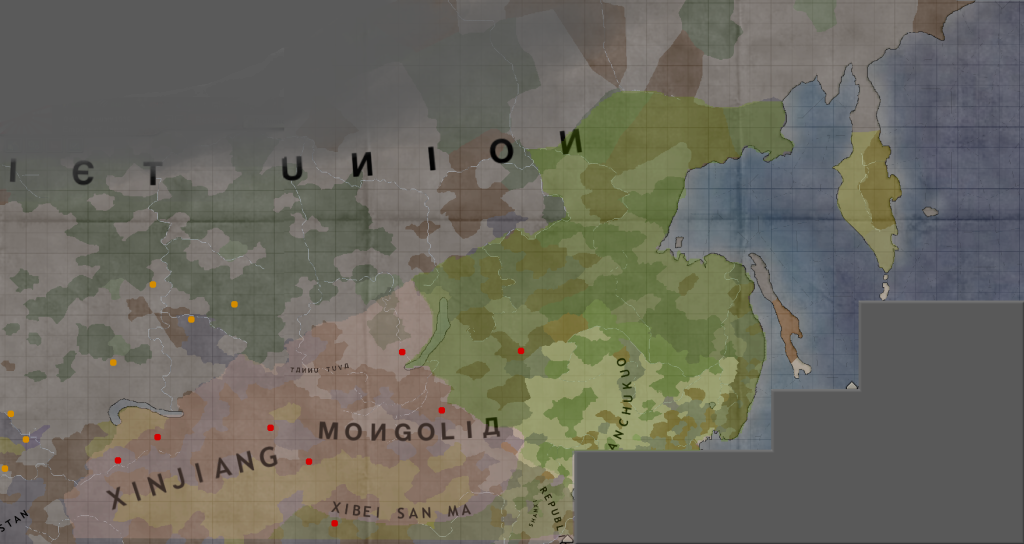Chapter Three, Part Six: Sino-Japanese War
Jul 1940 - Dec 1940
Previously in the Influence Wars...
Shanxi was conquered and the Japanese advanced inland, but were defeated at Changsha, Baofeng and Nanchang. The High Command created a plan which consisted of an attack from two sides which was supposed to result in an encirclement on a grand scale near Wuhan.
And now, the conclusion...
Politcs
Foreign politics

The most important news of the last months came in October - just when the Germans where approaching Paris,
the Soviet Union declared war on the German Reich, citing "an unprovoked act of aggression" against Czechoslovakia, Denmark, Poland and the Low Countries as the reason for war. For many this move came as a surprise, because wars in Lithuania and Finland proved that the Red Army was not ready for a prolonged conflict with a major power. Some, however, claimed that the Soviets did this because they were afraid that after the Germans are done with the western countries, the Reich will come for them next. This reason makes sense in the light of the fact that Adolf Hitler is known for his vehement anti-communist views. For Germany, this was the realisation of their worst fears - a war on two fronts which may easily turn into another Great War.
The declaration of war opened the question of Persia - a neutral country standing between the two powers - the British Empire and the Soviet Union - which now shared the common enemy. Due to British diplomatic pressure, Reza Shah Pahlavi abdicated in favour of his son, who declared war on Germany and their allies.
Hostilities in Europe discredited the appeasement policy and as a result,
Winston Churchill became the new Prime Minister of the UK.

Despite the fact that Germany is now fighting on two fronts, as these words are being written, the French are on the brink of collapse and may surrender any day. In the East, the frontline is more static - it seems that the Axis alliance adopted a defensive posture there in order to focus their attention on France first. Germany was supported by Slovakia, Hungary, Italy, Bulgaria and Romania (which had a coup d'etat in September and the new government signed the Anti-Comintern Pact), while the western powers have recently added another country to their alliance - the Kingdom of Sweden. It should be noted that to this date the Germans made no attempt at invading Norway. This apparent lack of naval prowess seems to differ significantly from their great successes on land.
When Italy supported Germany in their war against the West, it seemed that the world would witness a long and brutal struggle in North Africa and the Mediterranean. However, Italy seems to be poorly prepared for war, as the British made a daring and strong push in Libya and are currently besieging Benghazi.
Domestic matters
 The Soviet move against Germany removed all uncertainty and the Emperor fully supported Konoe Fumimaro as the next Prime Minister
The Soviet move against Germany removed all uncertainty and the Emperor fully supported Konoe Fumimaro as the next Prime Minister. His pro-Axis policy is most needed now, when the Axis alliance needs any support it can get. At the same time, though,
the Empire of Japan did not officially join the Axis, as this would restrict our potential diplomatic and strategic actions while we are still engaged in China.
The colonial powers did not take this move lightly and
soon enough, the USA, the UK, Netherlands, Belgium and various other countries aligned with the western powers put an embargo on the Empire of Japan. Fortunately, though, the Japanese stockpiles are now big enough to withstand the effects of the embargoes for some time. From now on it will be much harder to find sources of oil by diplomatic means, though.
The fascists approved of the appointment of Konoe and it seems that the nation is united in the support for the Axis. The only disappointment was the fact that the Empire did not join the Axis and the fascists are now pressing the government to do so.
This unity enables us to greatly increase the mobilisation of our economy for the war effort. If we make this move, though, the world will find the Empire even more threatening to the status quo.
The biggest question is how to respond to the recent developments in Europe. Most of our potential enemies are now engaged elsewhere, so if we act now, it is very likely that they will be unprepared for this move. However, war in China is still not over, which means that we would be opening new fronts willingly.
War in China
June-July - struggle near Wuhan


When two important battles in Qizhhou and Daye were won in June, it seemed that the fate of the Chinese armies was sealed. However, the enemy made a counter-attack in July which prevented the encirclement from being formed.
August Breakthrough


The real breakthrough came in August, when the Chinese fighting in coastal areas and in Nanchang were cut off from the temporary capital of Wuhan. They never managed to reconnet their lines again and thus the slow process of the destruction of the pocket began. The Japanese armies were ordered to approach the enemy conservatively, attacking only when victory was certain and without suffering unnecessary losses. Japanese heavy bombers were busy destroying the enemy's stockpiles and the infrastructure inside the pocket during daylight hours and lighter aircraft were pounding the enemy with smaller bombs throughout the days and nights. By early October, the enemy's armies were reduced to rubble.
This was probably the biggest Japanese victory during the Sino-Japanese War yet.
Northern troubles

While the bulk of our forces was engaged in Central China, the enemy made a very threatening counter-attack further north, which destroyed several of the infrastructure projects that were being developed there and resulted in the encirclement and destruction of one of our divisions. The Emperor immediately ordered the 1st AG to engage the Chinese in the north, but it took time for the troops to be redeployed and for a while the Chinese went almost unopposed.

Therefore, October brought both good and bad news.
The good news was that Wuhan fell to our forces. The bad news was that the northern Chinese counterattacked reached as far as Shanxi and it was a direct threat to the Northern HQ.
Fighting in Southern China

In October, the Chinese started a massive counter-attack in Southern China, which overwhelmed the Japanese and pro-Japanese Chinese forces stationed there by sheer numbers.
In early December, the Chinese regained control over Chongqing.
The situation in China became very frustrating for the Japanese soldiers - any time they manage to score a decisive victory in one place, the Chinese counter-attack elsewhere and regain the land which they lost. The common soldiers are talking about the conspiracies of fate and the gods, but the officers and the quartermasters know the truth - this is the result of the Chinese numerical superiority and the vastness of the area we have to control.
Overview of the situation in China

The Japanese armies in China were reorganised into four HQs, corresponding to their geographical position. We control the whole coastline and big areas of Central China, but the whole Western China and most of Northern and Southern China are still outside of our sphere of influence.
Other matters

 *If you are wondering about the 60k supply stockpile, this is because I had to edit the save-game and transfer some supplies from Shanghai to Tokyo - otherwise, the supply system in China would collapse, as there were no convoys running, because the game thought that were enough supplies in China due to big stockpile in Shanghai, not counting other areas. It is a known SF bug.
*If you are wondering about the 60k supply stockpile, this is because I had to edit the save-game and transfer some supplies from Shanghai to Tokyo - otherwise, the supply system in China would collapse, as there were no convoys running, because the game thought that were enough supplies in China due to big stockpile in Shanghai, not counting other areas. It is a known SF bug.
Merchantmen production was decreased, as the current size of the merchant marine was deemed sufficient and there are other, more important priorities. When the newest engines became available, production of a battlecruiser IJN Kurama was started. Also, another light carrier, IJN Shoho, was ordered as soon as modern carrier armour was developed.
Another heavy fighter wing was formed and yet another one will be formed in January 1941.
Infrastructure developments in China continue, although the Chinese counter-attack in the north caused some setbacks.
Japanese generals are now working on developing the future operational doctrine.
List of researched technologies during the covered period:
Small Warship ASW, Artillery techs, Mechanical Computing Machine, Scout Planes, Supply Production, Attritional Containment, Aircraft Carrier Deck Armour, Encryption Machine, Infantry Training, Battlecruiser Design & Engine, Interception Tactics, Supply Organisation & Transportation, Anti-Tank Barrel and Sights, Defensive Support Weapons.
Numbers of war





